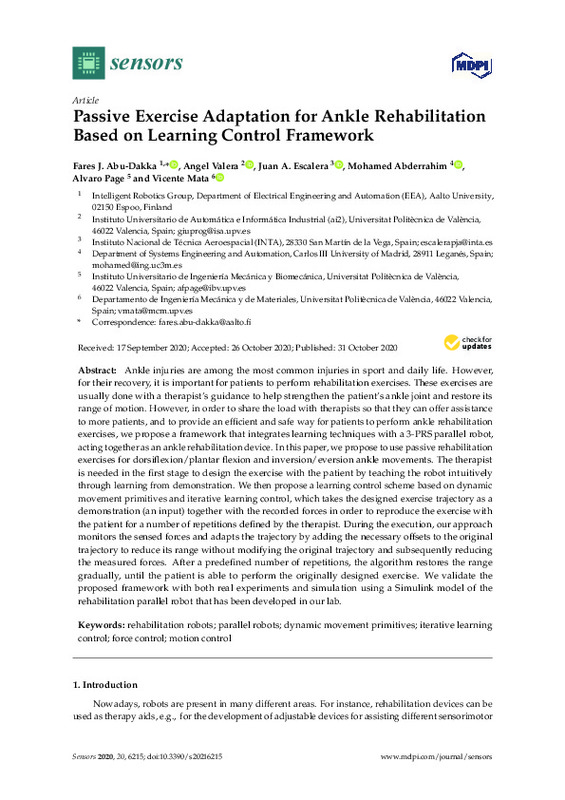JavaScript is disabled for your browser. Some features of this site may not work without it.
Buscar en RiuNet
Listar
Mi cuenta
Estadísticas
Ayuda RiuNet
Admin. UPV
Passive Exercise Adaptation for Ankle Rehabilitation Based on Learning Control Framework
Mostrar el registro sencillo del ítem
Ficheros en el ítem
| dc.contributor.author | Abu-Dakka, Fares J.
|
es_ES |
| dc.contributor.author | Valera Fernández, Ángel
|
es_ES |
| dc.contributor.author | Escalera, Juan A.
|
es_ES |
| dc.contributor.author | Abderrahim, Mohamed
|
es_ES |
| dc.contributor.author | Page Del Pozo, Alvaro Felipe
|
es_ES |
| dc.contributor.author | Mata Amela, Vicente
|
es_ES |
| dc.date.accessioned | 2021-11-05T14:08:59Z | |
| dc.date.available | 2021-11-05T14:08:59Z | |
| dc.date.issued | 2020-11 | es_ES |
| dc.identifier.uri | http://hdl.handle.net/10251/176352 | |
| dc.description.abstract | [EN] Ankle injuries are among the most common injuries in sport and daily life. However, for their recovery, it is important for patients to perform rehabilitation exercises. These exercises are usually done with a therapist's guidance to help strengthen the patient's ankle joint and restore its range of motion. However, in order to share the load with therapists so that they can offer assistance to more patients, and to provide an efficient and safe way for patients to perform ankle rehabilitation exercises, we propose a framework that integrates learning techniques with a 3-PRS parallel robot, acting together as an ankle rehabilitation device. In this paper, we propose to use passive rehabilitation exercises for dorsiflexion/plantar flexion and inversion/eversion ankle movements. The therapist is needed in the first stage to design the exercise with the patient by teaching the robot intuitively through learning from demonstration. We then propose a learning control scheme based on dynamic movement primitives and iterative learning control, which takes the designed exercise trajectory as a demonstration (an input) together with the recorded forces in order to reproduce the exercise with the patient for a number of repetitions defined by the therapist. During the execution, our approach monitors the sensed forces and adapts the trajectory by adding the necessary offsets to the original trajectory to reduce its range without modifying the original trajectory and subsequently reducing the measured forces. After a predefined number of repetitions, the algorithm restores the range gradually, until the patient is able to perform the originally designed exercise. We validate the proposed framework with both real experiments and simulation using a Simulink model of the rehabilitation parallel robot that has been developed in our lab. | es_ES |
| dc.description.sponsorship | This work has been partially funded by the FEDER-CICYT project with reference DPI2017-84201-R (Integracion de modelos biomecanicos en el desarrollo y operacion de robots rehabilitadores reconfigurables) financed by Ministerio de Economia, Industria e Innovacion (Spain). | es_ES |
| dc.language | Inglés | es_ES |
| dc.publisher | MDPI AG | es_ES |
| dc.relation.ispartof | Sensors | es_ES |
| dc.rights | Reconocimiento (by) | es_ES |
| dc.subject | Rehabilitation robots | es_ES |
| dc.subject | Parallel robots | es_ES |
| dc.subject | Dynamic movement primitives | es_ES |
| dc.subject | Iterative learning control | es_ES |
| dc.subject | Force control | es_ES |
| dc.subject | Motion control | es_ES |
| dc.subject.classification | INGENIERIA MECANICA | es_ES |
| dc.subject.classification | FISICA APLICADA | es_ES |
| dc.subject.classification | INGENIERIA DE SISTEMAS Y AUTOMATICA | es_ES |
| dc.title | Passive Exercise Adaptation for Ankle Rehabilitation Based on Learning Control Framework | es_ES |
| dc.type | Artículo | es_ES |
| dc.identifier.doi | 10.3390/s20216215 | es_ES |
| dc.relation.projectID | info:eu-repo/grantAgreement/AEI//DPI2017-84201-R-AR//INTEGRACION DE MODELOS BIOMECANICOS EN EL DESARROLLO Y OPERACION DE ROBOTS REHABILITADORES RECONFIGURABLES/ | es_ES |
| dc.rights.accessRights | Abierto | es_ES |
| dc.contributor.affiliation | Universitat Politècnica de València. Departamento de Física Aplicada - Departament de Física Aplicada | es_ES |
| dc.contributor.affiliation | Universitat Politècnica de València. Departamento de Ingeniería de Sistemas y Automática - Departament d'Enginyeria de Sistemes i Automàtica | es_ES |
| dc.contributor.affiliation | Universitat Politècnica de València. Departamento de Ingeniería Mecánica y de Materiales - Departament d'Enginyeria Mecànica i de Materials | es_ES |
| dc.description.bibliographicCitation | Abu-Dakka, FJ.; Valera Fernández, Á.; Escalera, JA.; Abderrahim, M.; Page Del Pozo, AF.; Mata Amela, V. (2020). Passive Exercise Adaptation for Ankle Rehabilitation Based on Learning Control Framework. Sensors. 20(21):1-23. https://doi.org/10.3390/s20216215 | es_ES |
| dc.description.accrualMethod | S | es_ES |
| dc.relation.publisherversion | https://doi.org/10.3390/s20216215 | es_ES |
| dc.description.upvformatpinicio | 1 | es_ES |
| dc.description.upvformatpfin | 23 | es_ES |
| dc.type.version | info:eu-repo/semantics/publishedVersion | es_ES |
| dc.description.volume | 20 | es_ES |
| dc.description.issue | 21 | es_ES |
| dc.identifier.eissn | 1424-8220 | es_ES |
| dc.identifier.pmid | 33142669 | es_ES |
| dc.identifier.pmcid | PMC7662251 | es_ES |
| dc.relation.pasarela | S\426122 | es_ES |
| dc.contributor.funder | AGENCIA ESTATAL DE INVESTIGACION | es_ES |
| dc.contributor.funder | European Regional Development Fund | es_ES |








